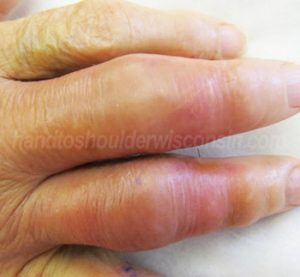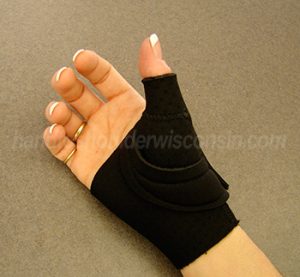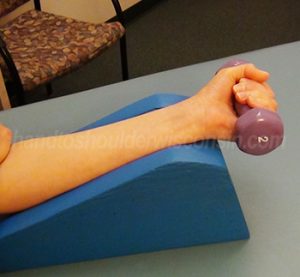If you believe you’re experiencing signs of osteoarthritis, including pain and loss of joint flexibility, contact Hand to Shoulder Center of Wisconsin in Appleton or Green Bay, WI. Our team of orthopedic specialists have experience diagnosing symptoms of osteoarthritis, and are here to provide you with treatment options.
Osteoarthritis (Finger, Hand, Wrist, Elbow, and Shoulder)
What is osteoarthritis? Osteoarthritis is a form of arthritis that causes deterioration to the cartilage that surrounds the ends of the bones. Cartilage is the firm, slippery tissue that serves as a “cushion” to the joint and allows for friction-less joint motion. In osteoarthritis, when the cartilage deteriorates or breaks down, the bone next to it becomes inflamed and rough, causing bone-on-bone friction. Often this activity will stimulate bone growth to develop, resulting in uneven surfaces or a bony deformity, called a “spur.” This bony deformity is often a characteristic of osteoarthritis in fingers and elbow osteoarthritis; however, bone spurs can develop elsewhere, as well. Osteoarthritis is the most common form of arthritis and affects millions of individuals throughout the world.
Osteoarthritis, also known as degenerative joint disease (DJD) or degenerative arthritis can affect any joint and commonly occurs with the aging process. It often affects the hands, knees, hips and spine but can attack any joint in the body. Men are at a higher risk of developing osteoarthritis before the age of 45 while women are more apt to develop it after age 55.
Symptoms of Osteoarthritis

Figure 1: Inflamed arthritic finger joints
Osteoarthritis symptoms can range from minimal to severe. Symptoms may include pain, inflammation, tenderness and stiffness (Fig. 1). Loss of flexibility in the joint and possibly a “grating” sensation may be heard or felt with movement. Range of motion is decreased and pain typically increases with movement. Typically, osteoarthritis in the hands will affect a number of joints in the fingers and base of the thumb, whereas, shoulder osteoarthritis can affect the acromioclavicular joint or the ball and socket joint (glenohumeral joint).
Diagnosis and Osteoarthritis Treatment
At Hand to Shoulder Center of Wisconsin, the physicians conduct a thorough examination. Review of medical history will be discussed in depth as osteoarthritis appears to have genetic components. In diagnosing finger osteoarthritis and/or hand osteoarthritis, our sub-specialty trained physicians will examine how your fingers, hands and joints look and function. Imaging, such as x-rays are often obtained; cartilage is not visible during x-rays, however, loss of cartilage can be detected due to the narrowing of space in the joints. Blood tests may be ordered in more complex cases to eliminate other arthritic conditions.
At present, osteoarthritis has no cure and typically progresses with time. In most cases genetic history plays an important role. Injuries and/or trauma can increase the chances of developing wrist osteoarthritis and osteoarthritis of the shoulder. This condition is often referred to as post-traumatic arthritis and may affect any joint.
Pain relief for osteoarthritis should be discussed directly with your physician. Osteoarthritis treatment options vary from case to case, depending on the pain and deterioration level of the cartilage. For non-surgical treatment options for osteoarthritis pain relief, your physician may include:
- Acetaminophen – to ease the stiffness and pain
- Nonsteroidal anti-inflammatory and/or naproxen drugs – to help reduce inflammation and pain
- Moist heat and/or cold applications may be suggested
- Rest and modification of your daily activities
- A prefabricated or customized splint or brace may be prescribed to alleviate pain and deter deformity (Fig. 2)
- Occupational and/or physical therapy for osteoarthritis is often ordered to reduce stiffness, improve joint mobility and gently increase strength of the affected upper extremity without exacerbating the pain (Fig. 3)
- Prescription medication may be ordered which may include corticosteroid injections for osteoarthritis
 Figure 2: A prefabricated splint is used to alleviate pain for thumb arthritis |
 Figure 3: Two pound weight is used to aid in wrist strengthening treatments |
In severe cases of osteoarthritis, surgery may be recommended when the patient develops severe pain with little mobility of the joint. Surgical options vary greatly and widely depend on the joint(s) affected, your anatomy and your activities. Surgical options may include:
- Fusing the joint – arthritic surface is removed and the joint is fused together eliminating movement of the joint
- Joint reconstruction – arthritic surface is removed and rolled up soft tissue, such as a tendon is applied to the affected joint, eliminating pain and bone on bone activities
- Joint replacement – arthritic surface is removed and an artificial device (prosthesis) will replace the damaged joint
At Hand to Shoulder Center of Wisconsin, the surgeons perform surgery at Woodland Surgery Center, adjacent to Hand to Shoulder Center of Wisconsin in Appleton or one of the three local hospitals in Appleton and Neenah. Postoperatively the patient attends therapy and a specific treatment plan is designed to best fit the patient’s needs.
